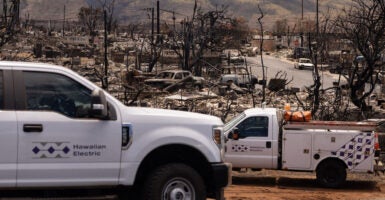Hawaiian Electric, the utility company whose power line reportedly played a role in the Hawaiian fires, appears to have focused on green energy development while neglecting to adhere to its own assessment that it needed to increase the safety of its existing infrastructure, The Wall Street Journal reported Wednesday.
The company concluded that it needed to take much more aggressive action to ensure that its hardware did not emit sparks after the 2019 wildfire season, which was one of the worst recorded in the island of Maui’s history, according to the Journal.

The firm does not appear to have done much work to that end before one of its power lines reportedly triggered the spark for last week’s fires that have killed at least 100 people, but it expended significant resources toward green energy initiatives in the years between its assessment and this week’s fires, according to the Journal.
“While there was concern for wildfire risk, politically the focus was on electricity generation,” Mina Morita, chair of the state utilities commission from 2011 to 2015, told the Journal.
Hawaiian Electric spent less than $245,000 on wildfire-specific projects on the island between 2019 and 2022, after it had determined in 2019 that it had to do more to mitigate the risks posed by errant sparks, according to the Journal.
Despite issuing a press release in 2019 pledging to take action to reduce wildfire risk and increase preparedness, the company appears to have mentioned wildfire danger as an afterthought rather than a priority in regulatory filings with the relevant state agency, according to the Journal.
REPORTER: “Mr. President, any comment on the rising death toll in Maui?”
— Daily Caller (@DailyCaller) August 14, 2023
BIDEN: “No. no comment.”
REPORTER 2: “Will you come talk about the Hawaii response, Mr. President?”
Crickets… pic.twitter.com/RdftKKcmPt
During the same years that Hawaiian Electric had pledged publicly to take more action on risk reduction, the company undertook a massive campaign to reach the state’s long-term green energy transition goals, according to the Journal.
A 2020 audit of the company’s management systems found that its risk considerations were mostly focused on financial risks, with minimal analysis of operational risks, while the division within the firm that oversaw power line operations had significant management problems.
“Looking back with hindsight, the business opportunities were on the generation side, and the utility was going out for bid with all these big renewable-energy projects,” Doug McLeod, who served for several years as the Maui county energy commissioner, told the Journal. “But in retrospect, it seems clear, we weren’t as focused on these fire risks as we should have been.”
Though Hawaiian Electric’s alleged failures in the lead-up to the disaster have drawn scrutiny and criticism, it is far from the only involved entity to have possibly contributed to the calamity with its alleged negligence.
While many Democrats moved quickly to emphasize the role climate change may have played in the catastrophe, reports have surfaced in recent days indicating that the questionable state land management policies and failures of the local 911 system, emergency sirens, and fire hydrants all contributed to the fires that engulfed Lahaina, a Maui town hit especially hard by the inferno.
The utility company has stated that it will cooperate fully with investigations into the origins and outcomes of the tragedy, according to the Journal.
Hawaiian Electric is one of the most politically influential and connected companies in all of Hawaii, but its finances and share price have been severely impacted as a result of the crisis and the stream of reports indicating that its hardware started the fire.
Hawaiian Electric did not respond immediately to a request for comment.
Originally published by the Daily Caller News Foundation
Have an opinion about this article? To sound off, please email [email protected] and we’ll consider publishing your edited remarks in our regular “We Hear You” feature. Remember to include the url or headline of the article plus your name and town and/or state.
































